Electrical Performance and Reliability Improvement of Amorphous-Indium-Gallium-Zinc-Oxide Thin-Film Transistors with HfO2 Gate Dielectrics by CF4 Plasma Treatment
Abstract
:1. Introduction
2. Device Fabrication
3. Results and Discussion
4. Conclusions
Author Contributions
Funding
Acknowledgments
Conflicts of Interest
References
- Nomura, K.; Ohta, H.; Takagi, A.; Kamiya, T.; Hirano, M.; Hosono, H. Room-temperature fabrication of transparent flexible thin-film transistors using amorphous oxide semiconductors. Nature 2004, 432, 488–492. [Google Scholar] [CrossRef] [PubMed]
- Yabuta, H.; Sano, M.; Abe, K.; Aiba, T.; Den, T.; Kumomi, H.; Nomura, K.; Kamiya, T.; Hosono, H. High-mobility thin-film transistor with amorphous InGaZnO4 channel fabricated by room temperature rf-magetron sputtering. Appl. Phys. Lett. 2006, 89, 112123. [Google Scholar] [CrossRef]
- Suresh, A.; Wellenius, P.; Dhawan, A.; Muth, J. Room temperature pulsed laser deposited indium gallium zinc oxide channel based transparent thin film transistors. Appl. Phys. Lett. 2007, 90, 123512. [Google Scholar] [CrossRef]
- Kamiya, T.; Nomura, K.; Hosono, H. Origins of High Mobility and Low Operation Voltage of Amorphous Oxide TFTs: Electronic Structure, Electron Transport, Defects and Doping. J. Disp. Technol. 2009, 5, 273–288. [Google Scholar] [CrossRef]
- Mativenga, M.; Choi, M.H.; Choi, J.W.; Jang, J. Transparent Flexible Circuits Based on Amorphous-Indium-gallium-Zinc-Oxide Thin-Film Transistors. IEEE Electron Device Lett. 2011, 32, 170–172. [Google Scholar] [CrossRef]
- Lee, I.; Lee, S.; Gu, J.; Kim, K.; Cho, W. Comparative Study of Device Performance and Reliability in Amorphous InGaZnO Thin-Film Transistors with Various High-k Gate Dielectrics. Jpn. J. Appl. Phys. 2013, 52, 06GE05. [Google Scholar] [CrossRef]
- Hsu, H.; Chang, C.; Cheng, C.; Chen, P.; Chiu, Y.; Chiou, P.; Cheng, C. High Mobility Field-Effect Thin Film Transistor Using Room-Temperature High-k Gate Dielectrics. J. Disp. Technol. 2014, 10, 875–881. [Google Scholar] [CrossRef]
- Pan, T.; Chen, C.; Liu, J.; Her, J.; Koyama, K. Electrical and Reliability Characteristics of High-k HoTiO3 a-InGaZnO Thin-Film Transistors. IEEE Electron Device Lett. 2014, 35, 66–68. [Google Scholar] [CrossRef]
- Shao, Y.; Xiao, X.; He, X.; Deng, W.; Zhang, S. Low-Voltage a-InGaZnO Thin-Film Transistors With Anodized Thin HfO2 Gate Dielectric. IEEE Electron Device Lett. 2015, 36, 573–575. [Google Scholar] [CrossRef]
- Huang, X.D.; Song, J.Q.; Lai, P.T. Positive Gate Bias and Temperature-Induced Instability of a-InGaZnO Thin-Film Transistor with ZrLaO Gate Dielectric. IEEE Trans. Electron Devices 2016, 63, 1899–1903. [Google Scholar] [CrossRef]
- Park, J.C.; Cho, I.; Cho, E.; Kim, D.H.; Jeong, C.; Kwon, H. Comparative Study of ZrO2 and HfO2 as a High-k Dielectric for Amorphous InGaZnO Thin Film Transistors. J. Nanoelectron. Optoelectron. 2014, 9, 67–70. [Google Scholar] [CrossRef]
- Kim, H.; Mclntyre, P.C.; Saraswat, K.C. Effects of crystallization on the electrical properties of ultrathin HfO2 dielectrics grown by atomic layer deposition. Appl. Phys. Lett. 2003, 82, 106–108. [Google Scholar] [CrossRef]
- Hu, H.; Zhu, C.; Lu, Y.F.; Wu, Y.H.; Liew, T.; Li, M.F.; Cho, B.J.; Choi, W.K.; Yakovlev, N. Physical and electrical characterization of HfO2 metal-insulator-metal capacitors for Si analog circuit applications. J. Appl. Phys. 2003, 94, 551–557. [Google Scholar] [CrossRef]
- Lin, Y.; Chou, J. Temperature Effects on a-IGZO Thin Film Transistors Using HfO2 Gate Dielectric Material. J. Nanomater. 2014, 2014, 72. [Google Scholar] [CrossRef]
- Son, D.; Kim, D.; Sung, S.; Jung, E.; Kang, J. High performance and the low voltage operating InGaZnO thin film transistor. Curr. Appl. Phys. 2010, 10, e157–e160. [Google Scholar] [CrossRef]
- Chun, Y.S.; Chang, S.; Lee, S.Y. Effects of gate insulators on the performance of a-IGZO TFT fabricated at room-temperature. Micoelectron. Eng. 2011, 88, 1590–1593. [Google Scholar] [CrossRef]
- Na, J.H.; Kitamura, M.; Arakawa, Y. High field-effect mobility amorphous InGaZnO transistors with aluminum electrodes. Appl. Phys. Lett. 2008, 93, 063501. [Google Scholar] [CrossRef]
- Choi, S.; Kim, H.; Jo, C.; Kim, H.; Choi, S.; Kim, D.M.; Park, J.; Kim, D.H. A Study on the Degradation of In-Ga-Zn-O Thin-Film Transistors under Current Stress by Local Variations in Density of States and Trapped Charge Distribution. IEEE Electron Device Lett. 2015, 36, 690–692. [Google Scholar] [CrossRef]
- Lee, J.; Cho, I.; Lee, J.; Kwon, H. Bias-stress-induced stretched-exponential time dependence of threshold voltage shift in InGaZnO thin film transistors. Appl. Phys. Lett. 2008, 93, 093504. [Google Scholar] [CrossRef]
- Huang, X.D.; Song, J.Q.; Lai, P.T. Improved Stability of a-InGaZnO Thin-Film Transistor under Positive Gate Bias Stress by Using Fluorine Plasma Treatment. IEEE Electron Device Lett. 2017, 38, 576–579. [Google Scholar] [CrossRef]
- Liu, X.; Wang, L.L.; Hu, H.; Lu, X.; Wang, K.; Wang, G.; Zhang, S. Performance and Stability Improvements of Back-Channel-Etched Amorphous Indium-Gallium-Zinc Thin-Film Transistors by CF4+O2 Plasma Treatment. IEEE Electron Device Lett. 2015, 36, 911–913. [Google Scholar] [CrossRef]
- Qian, L.Z.; Lai, P.T. Fluorinated InGaZnO Thin-Film Transistor with HfLaO Gate Dielectric. IEEE Electron Device Lett. 2014, 35, 363–365. [Google Scholar] [CrossRef]
- Jiang, J.; Toda, T.; Hing, M.P.; Wang, D.; Furuta, M. Highly stable fluorine-passivated In-Ga-Zn-O thin-film transistors under positive gate bias and temperature stress. Appl. Phys. Express 2014, 7, 114103. [Google Scholar] [CrossRef]
- Yamazaki, H.; Ishikawa, Y.; Fujii, M.; Ueoka, Y.; Fujiwara, M.; Takahashi, E.; Andoh, Y.; Maejima, N.; Matsui, H.; Matsui, F.; et al. The Influence of Fluorinated Silicon Nitride Gate Insulator on Positive Bias Stability toward Highly Reliability Amorphous InGaZnO Thin-Film Transistors. ECS J. Solid State Sci. Technol. 2014, 3, Q20–Q23. [Google Scholar] [CrossRef]
- Jiang, J.; Furuta, M.; Wang, D. Self-Aligned Bottom-Gate In-Ga-Zn-O Thin-Film Transistor with Source/Drain Regions Formed by Direct Deposition of Fluorinated Silicon Nitride. IEEE Electron Device Lett. 2014, 35, 933–935. [Google Scholar] [CrossRef]
- Furuta, M.; Jiang, J.; Hung, M.P.; Toda, T.; Wang, D.; Tatsuoka, G. Suppression of Negative Gate Bias and Illumination Stress Degradation by Fluorine-Passivated In-Ga-Zn-O Thin-Film Transistors. ECS J. Solid State Sci. Technol. 2016, 5, Q88–Q91. [Google Scholar] [CrossRef]
- Um, J.K.; Lee, S.; Jin, S.; Mativenga, M.; Oh, S.Y.; Lee, C.H.; Jang, J. High-Performance Homojunction a-IGZO TFTs with Selectively Defined Low-Resistive a-IGZO Source/Drain Electrodes. IEEE Trans. Electron Devices 2015, 62, 2212–2217. [Google Scholar] [CrossRef]
- Seo, J.; Jeon, J.; Hwang, Y.H.; Park, H.; Ryu, M.; Park, S.K.; Bae, B. Solution-Processed Flexible Fluorine-doped Indium Zinc Oxide Thin-Film Transistors Fabricated on Plastic Film at Low Temperature. Sci. Rep. 2013, 3, 2085. [Google Scholar] [CrossRef] [PubMed]
- Banuerfeldt, G.F.; Arbilla, G. Kinetic Analysis of the Chenical Processes in the Decomposition of Gaseous Dielectrics by a Non-Equilibrium Plasma-Part1:CF4 and CF4/O2. J. Braz. Chem. Soc. 2000, 11, 121–128. [Google Scholar] [CrossRef]

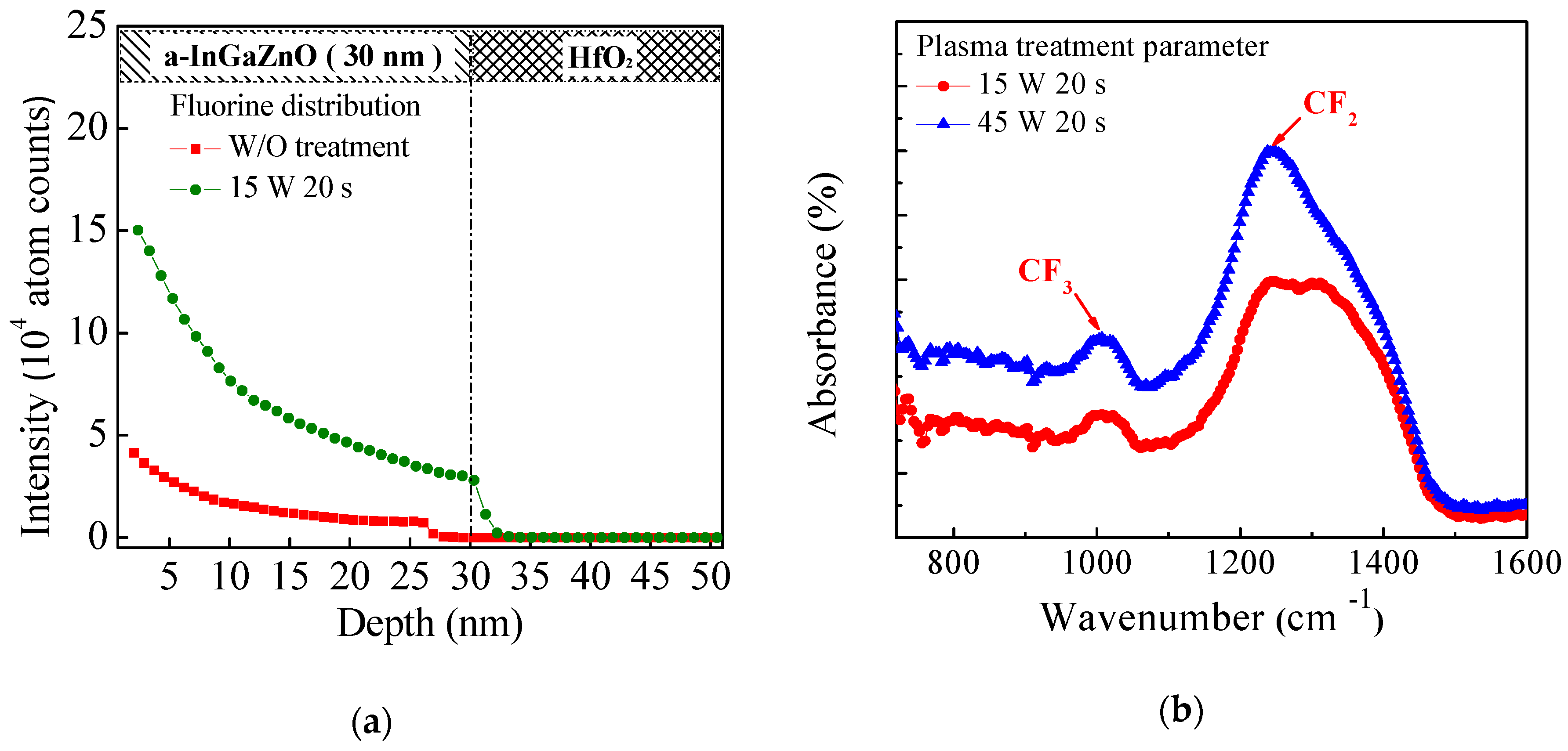
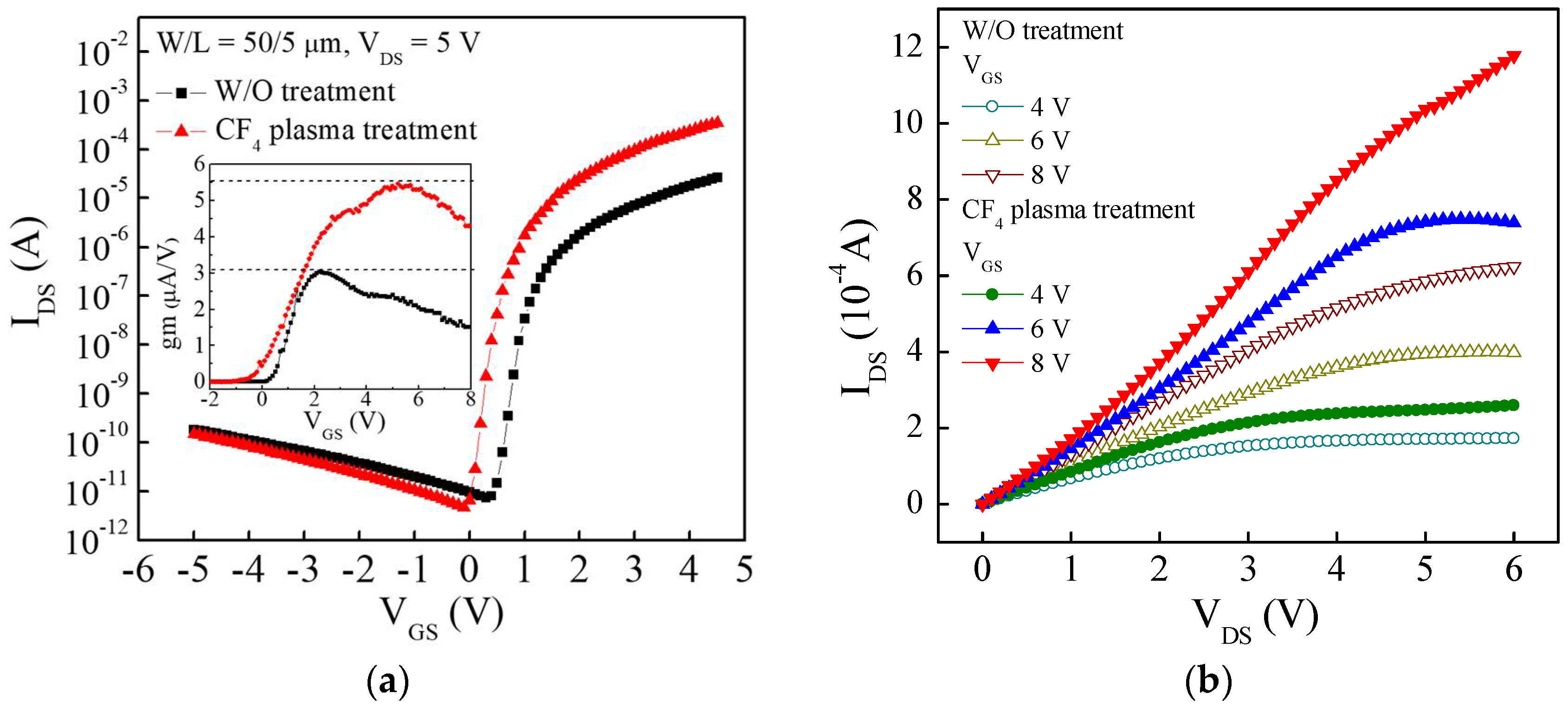
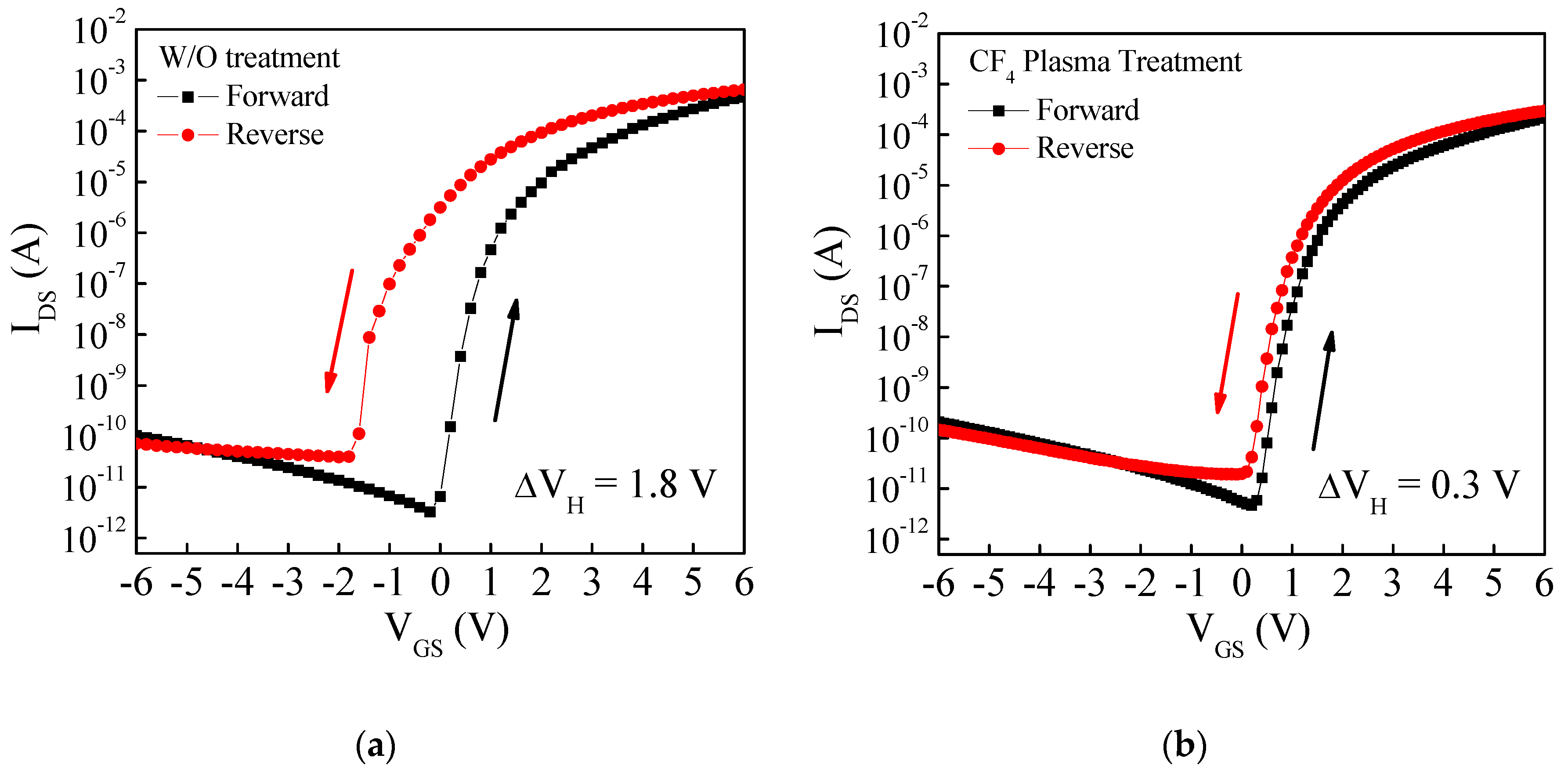
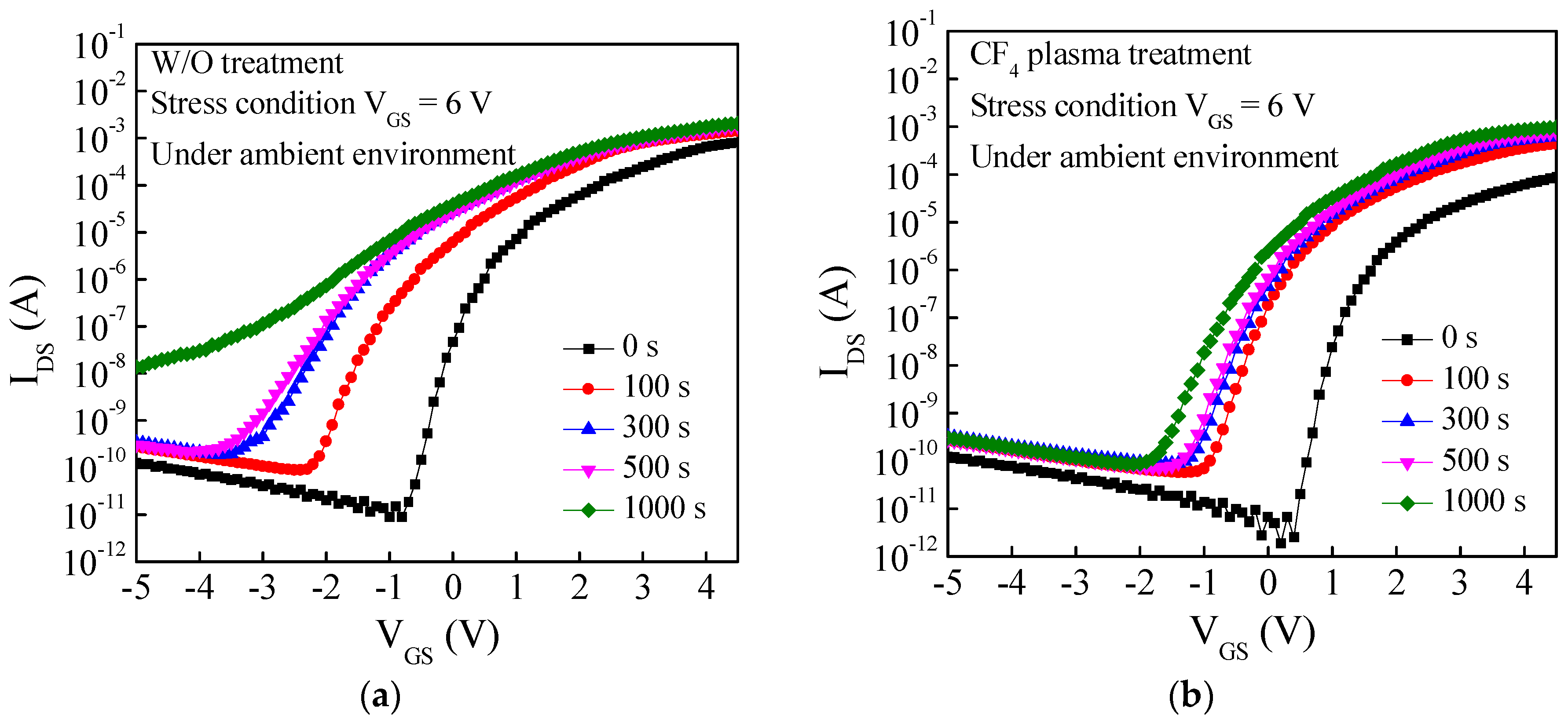
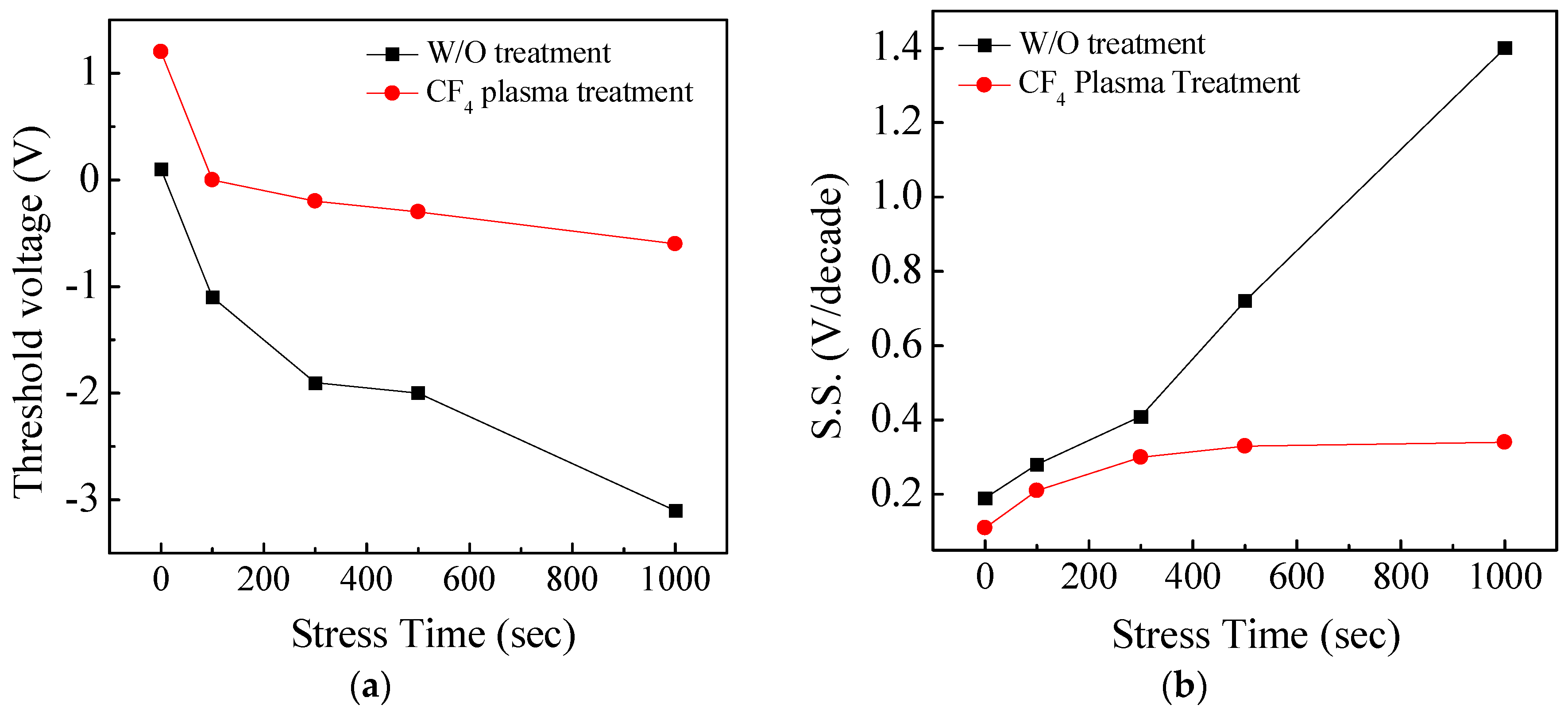
| Electrical Parameters | Without Treatment | With CF4 Plasma Treatment |
|---|---|---|
| µlinear (cm2/V∙s) | 30.2 | 54.6 |
| gmmax (A/V) | 3.02 × 10−6 | 5.46 × 10−6 |
| Vth (V) | 1.50 | 1.05 |
| S.S. (V/decade) | 0.17 | 0.14 |
| Ion/Ioff | 3.5 × 106 | 7.44 × 107 |
© 2018 by the authors. Licensee MDPI, Basel, Switzerland. This article is an open access article distributed under the terms and conditions of the Creative Commons Attribution (CC BY) license (http://creativecommons.org/licenses/by/4.0/).
Share and Cite
Fan, C.-L.; Tseng, F.-P.; Tseng, C.-Y. Electrical Performance and Reliability Improvement of Amorphous-Indium-Gallium-Zinc-Oxide Thin-Film Transistors with HfO2 Gate Dielectrics by CF4 Plasma Treatment. Materials 2018, 11, 824. https://doi.org/10.3390/ma11050824
Fan C-L, Tseng F-P, Tseng C-Y. Electrical Performance and Reliability Improvement of Amorphous-Indium-Gallium-Zinc-Oxide Thin-Film Transistors with HfO2 Gate Dielectrics by CF4 Plasma Treatment. Materials. 2018; 11(5):824. https://doi.org/10.3390/ma11050824
Chicago/Turabian StyleFan, Ching-Lin, Fan-Ping Tseng, and Chiao-Yuan Tseng. 2018. "Electrical Performance and Reliability Improvement of Amorphous-Indium-Gallium-Zinc-Oxide Thin-Film Transistors with HfO2 Gate Dielectrics by CF4 Plasma Treatment" Materials 11, no. 5: 824. https://doi.org/10.3390/ma11050824




